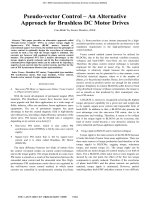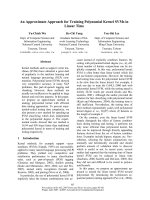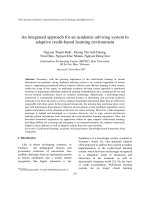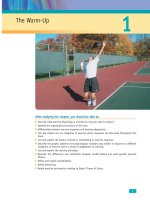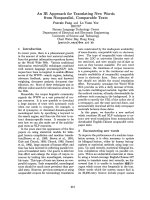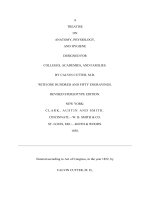NLP Coaching: An Evidence-Based Approach for Coaches, Leaders and Individuals potx
Bạn đang xem bản rút gọn của tài liệu. Xem và tải ngay bản đầy đủ của tài liệu tại đây (1.46 MB, 250 trang )
NLP
COACHING
THIS PAGE INTENTIONALLY
LEFT BLANK
ii
AnÊevidence-basedÊapproachÊforÊ
coaches,ÊleadersÊandÊindividuals
SusieÊLinder-Pelz
NLP
COACHING
Publisher’s note
British Library Cataloguing-in-Publication Data
Library of Congress Cataloging-in-Publication Data
Contents
Introduction 1
Part 1 NLP and coaching
1 What is NLP coaching? 15
2 Catching a coach at work 21
3 The ‘magic’ of NLP 40
4 Meeting industry standards 52
5 Shi�ing paradigms 58
Part 2 An evidence-based approach to NLP coaching
6 Best practice is evidence-based 67
7 Systemic principles with psychological overlay 73
8 Links to psychology 95
‘’
9 Empirical evidence 103
Part 3 Towards best practice
10 Building on NLP coaching 117
11 Working as a practitioner-researcher 139
‘’
12 Benchmarking and evaluating competencies 151
Conclusion 162
vi CONTENTS
Acknowledgements
’
THIS PAGE INTENTIONALLY
LEFT BLANK
viii
Introduction
Many organizations try to reduce or control [the complexity that is a fabric
of our working lives] and this simply isn’t possible. It’s not about tackling
complexity but more a case of understanding what it means for how we
work to develop people and organizations.
1
Coaching is a collaborative process of facilitating a client’s ability to self-
direct learning and growth, as evidenced by sustained changes in self-
understanding, self-concept and behaviour.
2
2 NLP COACHING
’
What is NLP?
NLP addresses things that people are not aware of. Although people talk
to themselves they usually don’t hear themselves or realise the effect of
what they say. So, for example, saying ‘I’m not confident at interviews’
leads to unconscious thoughts, pictures and feelings about interviews;
that leads the person to speak and present themselves at interview in a
less than helpful way.
NLP is about bringing the unconscious to awareness; having clients
notice how they feel as a result of what and how they speak to themselves
and how that colours their experience, how they limit themselves and
their idea of what’s possible. How people feel is a result of the language
they use; it colours their feelings or how they see the world, the day,
themselves as ‘bright’ or ‘grey’. This is how people block themselves and
don’t take actions they want to or are unable to imagine other solutions.
INTRODUCTION 3
NLP is for people who have admired someone excelling, who have a
goal they haven’t achieved or who have experienced unwanted emotions.
It is about how people organise their thoughts, their ways of representing
the world and their experience of it; that is, their memories, their
responses in the present and ways they imagine the future unfolding. The
key to NLP is that the founders, Richard Bandler and John Grinder, found
ways of investigating what was occurring outside of peoples’ conscious
awareness. Those mental processes – which include activity in their brain,
in the rest of their central nervous system and in their body – result in
the storing of information relating to beliefs, values, memories, habits
and more. So NLP gives coaches ways to investigate clients’ goals and
outcomes, to recognise the processes that stop them achieving their goals
and to address the processes that underlie any emotional issue. NLP is
about bringing unconscious processes into awareness so as to remove
blocks and bring new, better quality to their internal experience.
’
‘’’
Out of our neurology (nervous system, brain stem, cerebral cortex etc)
arise our unique human powers of symbolization and language; we live in
language and language constructions because that is how we make sense
of the world. Words express thoughts, beliefs, understandings, mental
maps; changing the words we use can change minds and meanings.
(Michael Hall, cognitive psychologist and NLP trainer.
7
)
’
4 NLP COACHING
‘
’
Some NLP coaches focus somewhat enthusiastically, if not bombastically,
on the tools of NLP rather than the more important principles of listening,
reflecting, supporting and facilitating. Therefore many serious coaches
are dis-identifying with NLP per se. It would be good to understand what
makes coaching exquisite as opposed to a set of tools that people use
more or less effectively. A lot of academics and psychologists so far have
missed that exquisiteness.
11
INTRODUCTION 5
‘
’
NLP originally developed as a form of psychotherapy in the 1970s. NLP
authors tend to quote one another rather than linking with the wider
worlds of psychotherapy, communication training etc and their methods
have often been experience-based rather than research-based, so it can
be difficult to evaluate them in an independent and broadly informed
way.
14
Questions this book addresses
6 NLP COACHING
Dan was a Human Resources director who had done a lot of coaching and
advising employees. He thought a lot about these issues and now was
very curious about methodologies that purportedly help resolve conflicts
(internal conflicts as well as those between people) and boost productivity.
He had read about NLP and although he was rather sceptical, he needed
to know more. Kate, another trainee coach, had taken to NLP with gusto;
she had already done a weekend programme in it and had started a
practitioner training programme. People skills were Kate’s strength and
she was driven to learn more because she was so dedicated to her clients
and loved seeing the difference coaching can make.
As Dan asked questions about research Kate’s eyes would initially glaze
over. As far as she was concerned, all that mattered was that NLP worked;
she could see it in how her clients responded and she could feel it in their
relief and excitement. But she was aware that some professionals and
students of change, managers, psychologists, learning and development
professionals, educators and researchers in the coaching and corporate
worlds were critical of NLP and understood that she needed to address
that.
’
What is needed is an evidenced-based approach to NLP, grounding
NLP material in previous psychological research, questioning aspects of
NLP where the evidence from research is missing, taking the best bits,
developing NLP less as pop psychology and moving towards a science-
practitioner model… I would really like to see an NLP coaching book
which grounds NLP techniques in evidence and which challenges some of
the floss which NLP can have.
17
INTRODUCTION 7
‘’
‘’
’
‘
’
8 NLP COACHING
Who is this book for?
My researcher-practitioner perspective
‘’
’
’
INTRODUCTION 9
Mind the gap
’
Figure 0.1
Rigour
Vigour
10 NLP COACHING
’
’
‘’‘’
‘’
Outline of chapters
Part 1: NLP and coaching
‘’
‘’
Part 2: An evidence-based approach to
NLP coaching
‘’‘’
‘’
INTRODUCTION 11
Part 3: Towards best practice
THIS PAGE INTENTIONALLY
LEFT BLANK
12
Part I
NLP and coaching
THIS PAGE INTENTIONALLY
LEFT BLANK
14
1
What is NLP coaching?
’
’
A 38-year-old manager who came for coaching said, ‘I do the managerial
thing perfectly well, but it doesn’t feel right. I want to know what will
make me happy. Should I stay in this job or look for another one? I feel
I should be able to sort this out by myself, but I seem to be going round
in circles. Often I’m full of fear about how I perform. I feel overburdened
with the workload and the responsibility. And I’m not enjoying the work.
It’s so frustrating.’
16 NLP AND COACHING
A bit of background
’
The events presented to us in First Access… are the product of a series
of neurological transforms beginning at the point where our receptors
and the external world collide… This ‘first access’ is already a set of
transformed representations, though it is prior to consciousness, pre-
verbal and beyond our ability to influence. The second set of transforms is
those of natural language and its derivative forms – formal systems such
as logic – which result in our linguistically mediated mental maps.
2
’
‘’
